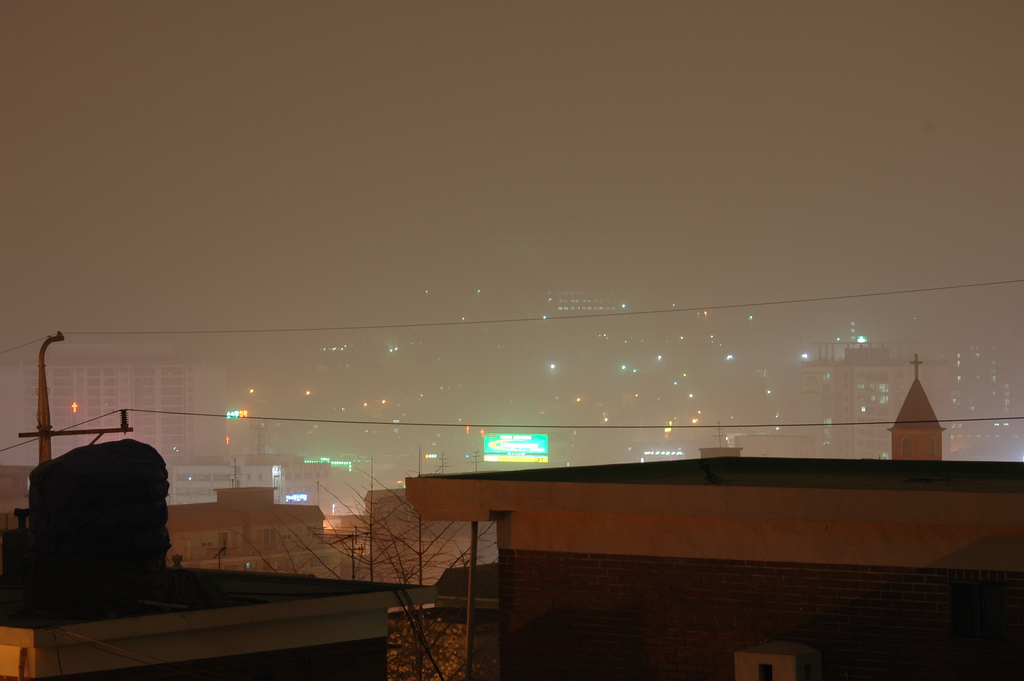
At night, Seoul’s city lights shine through dust blown in from the Gobi desert. Photo © Abri le Roux, licensed Creative Commons Attribution.
Thanks to innovations such as natural-gas bus fleets, the designation of greenbelts, and tighter restrictions on factories, South Korea’s air quality has improved, especially in larger cities such as notoriously smoggy Seoul. Concentrations of substances such as particulate matter and carbon monoxide now remain within recommended limits most days of the year. That said, with so much traffic and industrial activity concentrated in a relatively small area, the Alps it’s not. People used to more rural or pristine climes may experience some minor throat or lung irritations after moving here. People used to more rural or pristine climes may experience some minor throat or lung irritations after moving here.By far the biggest air-quality issue is not one of South Korea’s making; every spring winds bring to the peninsula from neighboring China the dreaded hwangsa, or “yellow dust.” This originates in China’s expanding western deserts and picks up pollutants from cities on the heavily populated coast before continuing east to the Korean peninsula and Japan. The dust can cause respiratory problems, especially for the elderly and very young, and at its peak authorities usually call on people to stay indoors. Multiple television and radio stations and government websites offer regularly updated air-quality data.Water quality in South Korea is generally fair, though pollution, usually from industrial sources and the discharge of sewage, remains an issue in some rivers and coastal areas. The water supplied to homes is perfectly safe to use for bathing and apparently suitable for drinking, though most expatriates and locals stick to bottled water or install water filtration systems. The water served in restaurants is usually boiled or filtered.
While ads discourage the habit and nonsmoking zones are starting to pop up in places, in general it’s open season for cigarette smokers in South Korea, which views tobacco with a permissiveness not seen in North America for decades. By some estimates close to half of all adult men are smokers. Cigarettes are dirt cheap and readily available everywhere, and a lot of restaurants and nightspots allow people to puff away wherever they like. Of course this leniency is extended only to men—South Koreans still view women smoking as strange, racy even, and while it’s become more common to see girls lighting up on the street, many women will avoid doing so if they’re not in or near a trendy café or nightspot.
The tide is slowly turning. Authorities have banned smoking in government facilities and large office complexes, for example, and the Seoul government plans to progressively roll out a smoking ban to all the city’s restaurants by 2015. Nonsmoking bars have also emerged in areas like Seoul’s cosmopolitan Itaewon district. However, for the time being, in many venues (bars in particular) nonsmokers have little choice but to grimace and bear it. Smokers, on the other hand, will have found their own little slice of heaven.
Sanitary conditions are generally quite good, and it’s rare these days to come across a home or building in South Korea without access to modern plumbing, though in some areas squat-style toilets are still the norm. Restaurants, especially busy ones, are kept pretty spotless, and cases of food poisoning or contamination are fairly uncommon. Some caution needs to be exercised with street food, especially seafood, which is sometimes left sitting around without proper heating or refrigeration. Frequenting popular stalls where there’s a high food turnover is the easiest way to avoid problems.
Excerpted from the Second Edition of Moon Living Abroad in South Korea.